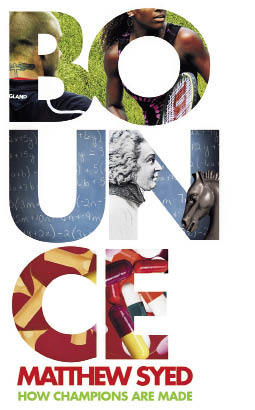Are great sportsmen born with high talent, or do they win prizes through years of application? That question, as old as sport itself, forms the basis of this book, which tries to inform readers ‘how champions are made’.
Are great sportsmen born with high talent, or do they win prizes through years of application? That question, as old as sport itself, forms the basis of this book, which tries to inform readers ‘how champions are made’. The author, a former Commonwealth table-tennis champion who is now a journalist, has investigated the subject thoroughly — too thoroughly, it might be said — but fails to make his case. For sport, like life, is odder than we think.
In attempting to make top-level sport appear democratic — that is, within the scope of everybody, or at least most people — Matthew Syed succeeds only in reminding us that it is a tyranny. Few champions glide effortlessly to the top. Whatever the discipline, most spend years refining the gifts they were born with, but the evidence is undeniable. Practice and determination can take the most enthusiastic performer so far, and no further. The gilded few have something, recognisable yet largely unquantifiable, which sets them apart.
In his introductory chapter Syed asks: ‘Is talent what we think it is?’ More than 250 pages later, after ploughing through dozens of glowing references to sports psychologists and university researchers, the answer is plain as day. The highest achievers, the Peles and Alis, the Nicklauses and Federers, do not hog the spoils because they practise harder than others. In fact, in the case of Sir Garfield Sobers, who is unaccountably overlooked in this study, the opposite may well be true. Sobers, the greatest all-round cricketer of all, was usually to be found on the golf course in his social hours.
Syed, however, won’t have it. Talent, he believes, is ‘a largely defunct concept’. Each of us has ‘the potential to tread the path to excellence’. To think otherwise robs ‘individuals and institutions of the motivation to change themselves and society’. Steady the Buffs! It takes all sorts of human skills to grease the wheels of our institutions, and not everybody is equally talented. You don’t have to read a single sentence by a sports psychologist to work that out.
Unwisely Syed ropes in some unlikely people to buttress his argument. Picasso, described as ‘innovative and influential’, apparently needed years of experience to paint Guernica. Well I never! More important, one might have thought, he had a temperament, a vision if you prefer, that doesn’t feature in Syed’s reductive interpretation of human achievement.
Mozart is also brought down a peg or two. Little Wolfgang may have been blessed with ‘intricate creativity’, whatever that is, but it was the 3,500 hours of practice before his sixth birthday that set him on his way. Remember that the next time you listen to Cosi fan tutte or the D minor piano concerto. It might be unkind to summon the spirit of Sir Neville Cardus, but as Syed chooses to mention Mozart he is no position to complain. ‘That a Mozart was born once, and once and for all’, wrote Cardus, ‘defies all known biology, physics, metaphysics … and all cosmogony whatever’. Such phenomena do not figure in Syed’s world.
One might warm to this book more if it was written with greater felicity. Unfortunately Syed adopts the breathless manner of a sixth-former desperate to impress the examiners and scatters clichés over the pages with the gladdest of hands. There are ‘paradigm shifts’ and (yes, he really does use the phrase) ‘silky skills’. Edges are always cutting, ‘frees up’ does service for that perfectly good verb, ‘liberate’, books are ‘seminal’, and there is plenty of room for ‘sublime’ (an adjective best kept out of sports writing) and ‘odyssey’, a word that Syed, like many of his ilk, appears not to understand. It doesn’t mean a long journey. It means a journey, like the one undertaken by Odysseus, which ends where it began.
It is an ambitious book undermined by a clunking style, and an eagerness to find profundity where none exists. This kind of sportswriting goes down better in the US, and the book is clearly designed for that market, as many of Syed’s examples are borrowed from the (not terribly interesting) world of American sport. But if you crave ‘mysterious sparks and life-changing mindsets’ then this may be just the book for you.





Comments